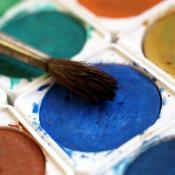 Depression can be challenging. If you have experienced it, then you know that the most basic tasks can become excruciating and leave you feeling apathetic and drained of your willpower. Simple tasks like getting out of bed, doing the laundry, and playing with your children may be daunting. While talk therapy and medications may be helpful, they are not the only solutions to relieving symptoms. This is where art therapy comes in. Art therapy has become an effective treatment in supporting, releasing, and integrating the symptoms of depression by supporting you in exploring depression via the senses. Although art might seem less conventional, it can be just as effective as talk therapy because it utilizes the whole body experience and not just the intellect.
Depression can be challenging. If you have experienced it, then you know that the most basic tasks can become excruciating and leave you feeling apathetic and drained of your willpower. Simple tasks like getting out of bed, doing the laundry, and playing with your children may be daunting. While talk therapy and medications may be helpful, they are not the only solutions to relieving symptoms. This is where art therapy comes in. Art therapy has become an effective treatment in supporting, releasing, and integrating the symptoms of depression by supporting you in exploring depression via the senses. Although art might seem less conventional, it can be just as effective as talk therapy because it utilizes the whole body experience and not just the intellect.
When Words Do Not Speak
It can be difficult to open up to a complete stranger about your deepest and darkest emotions. Sometimes, we are taught to suppress our emotions and put on a blank face, even when experiencing inner turmoil. In art therapy, words are not always necessary. A mere lump of clay or a blank canvas can be far less threatening than giving voice to painful feelings, words, or images. The simple act of a scribble on paper can likely bring light to darkness, ignite conversation, or be a release for a depressing thought. Because something cannot be heard by the human ear does not mean that nothing is being said or revealed. Art therapy supports our process when words are not enough.
The Capacity to Feel Again
In addition to creating a communication bridge between you and your therapist, art therapy can also help you come to terms with what you are actually feeling. Perhaps you have felt numb or distanced and “incapable” of feeling when depressed. Creating art is at the heart of expression and emotion, supporting your capacity to feel again. Once you have created and externalized a part of yourself as something concrete and tangible, it is easier to acknowledge that such an emotion existed in the first place. By creating, you give yourself permission and voice to that which is difficult to speak. You might feel a sense of relief or a movement of your depression once you have transferred it onto your canvas.
Creating One’s Own Happiness
Research shows that when we observe something that we believe to be beautiful, the neurotransmitter dopamine—located in one of our pleasure centers in the brain—is released. Interestingly, the brain activity observed when we look at art is actually comparable to the brain activity representing love! It’s nice to know that in addition to having created your own art, positive feelings increase.
Research proves art therapy is a beneficial method of treating depression across a wide spectrum of personalities. Many even discover a newfound passion for art and are surprised at the talent that emerges once their emotions are channeled into their artwork. Only in this unique field are therapists performing what is considered by traditional psychoanalysts to be the hardest of tasks: getting those with depression to proactively express, manage, and overcome their symptoms … with the end result being something truly beautiful.
References:
- Study shows art may help with depression. (2012, June 6). Retrieved from http://www.arttherapyblog.com/mental-health/study-shows-art-may-help-with-depression/#.T9dlRdUth30
- Bar-Sela, G. (2007, Nov. 16). Art therapy improved depression and influenced fatigue levels in cancer patients on chemotherapy. Retrieved from http://www.ncbi.nlm.nih.gov/pubmed/17351987
- Holm, M. (2011, Aug. 11). Art therapy for depression. Retrieved from http://www.naturaltherapypages.com.au/article/art_therapy_for_depression
- Riley, S. (2001, July). Art therapy with adolescents. Retrieved from http://www.ncbi.nlm.nih.gov/pmc/articles/PMC1071468
- Vann, M. (2012, April 4). 8 Unconventional ways to ease depression. Retrieved from http://www.everydayhealth.com/depression-pictures/unconventional-ways-to-ease-depression.aspx#/slide-3

The preceding article was solely written by the author named above. Any views and opinions expressed are not necessarily shared by GoodTherapy.org. Questions or concerns about the preceding article can be directed to the author or posted as a comment below.

 Creative Healing: Frequently Asked Questions about How Art Therapy Works
Creative Healing: Frequently Asked Questions about How Art Therapy Works Five Things I Learned About Autism from My Art Therapist
Five Things I Learned About Autism from My Art Therapist Collage Therapy: Integrating the Gift of Loneliness
Collage Therapy: Integrating the Gift of Loneliness

Please fill out all required fields to submit your message.
Invalid Email Address.
Please confirm that you are human.
Leave a Comment
By commenting you acknowledge acceptance of GoodTherapy.org's Terms and Conditions of Use.